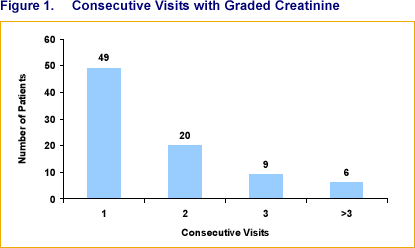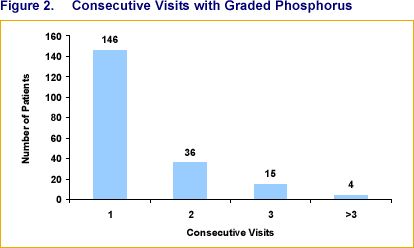 |
 |
 |
| |
2 Year Long Term Safety Profile of Tenofovir DF (TDF) in Treatment-Experienced Patients from Randomized, Double-Blind, Placebo-Controlled Clinical Trials
|
| |
| |
Poster at 9th European AIDS Conference (EACS), October 2003, Warsaw, Poland
AK Cheng, SS Chen, M Wulfsohn, and JJ Toole Gilead Sciences, Inc., Foster City, CA, USA
Reported by Jules Levin
Tenofovir disoproxil fumarate (tenofovir DF) is a nucleotide reverse transcriptase inhibitor (NtRTI) with the following characteristics: --Single tablet, once-daily dosing --Activity against wild-type and most nucleoside-resistant HIV --Activated in resting and dividing T cells --Additive or synergistic activity with other antiretrovirals in vitro
Data were pooled from 2 randomized, placebo-controlled studies
- 186-patient Phase 2 study, GS-98-902
- 550-patient Phase 3 study, GS-99-907
Patients in both studies added TDF or placebo to existing standard background antiretroviral therapy (SBT)
The “TDF 300 mg” group (n=443) includes
- All patients in Studies 902 and 907 randomized to TDF 300 mg
- Those placebo patients who later received TDF 300 mg in Study 902
The “All TDF” group (n=687) includes
- All patients in the “TDF 300 mg” group
- Placebo patients who later received TDF 300 mg in Studies 902 and 907
- Patients who initially received 75 mg or 150 mg for 48 weeks in Study 902 who later received TDF 300 mg
DEMOGRAPHICS and BASELINE HIV DISEASE CHARACTERISTICS
Baseline patient characteristics were similar for all groups: mean viral load 3.40-3.43 log10 copies/ml; mean CD4 count 411-428; 86-89% men; 41-42 yrs old. At baseline, the mean duration of prior ART use for all patients was about 5 yrs. The mean time on study was 113 weeks, with a maximum of 220 weeks.
AUTHOR’S CONCLUSIONS
Long-term follow-up in the placebo-controlled Phase 2-3 studies shows:
- Incidence and severity of adverse events and laboratory abnormalities remain low
- The incidence of discontinuation due to adverse events was 13%. 1% patients discontinued due to renal events. 1 patient developed Fanconi Syndrome.
No indication of clinically significant nephrotoxicity in these highly treatment-experienced patients with exposure of up to 4 years
Table 2. Grade 3 or 4 Adverse Events & Lab Abnormalities (occurring in >2% of patients in any group)
|
|
| |
| |
| |
Plb+SBT |
TDF 300mg+SBT |
All TDF+SBT |
| |
0-24 wks |
0-24 wks |
mean=113 wks |
| # of patients |
210 |
443 |
687 |
| Grade 3/4 AE |
| Diarrhea |
2% |
<1% |
3% |
| Depression |
<1% |
<1% |
3% |
| Grade 3/4 |
| Lab Creatine kinase |
14% |
8% |
15% |
| Triglycerides ele |
13% |
8% |
13% |
| Amylase elevation |
7% |
5% |
9% |
| AST elevation |
3% |
4% |
9% |
| Urine glucose ele |
3% |
3% |
7% |
| Serum glucose ele |
4% |
2% |
5% |
| ALT elevation |
2% |
2% |
6% |
| Neutropenia |
1% |
1% |
3% |
|
|
| |
| |
Table 3. Graded Renal Abnormalities |
|
| |
| |
| |
Placebo |
TDF 300mg+SBT |
All TDF+SBT |
| |
0-24 wks |
0-24 wks |
mean=113 wks |
| # of pts |
210 |
443 |
687 |
| Graded serum |
| Creatinine (mg/dL) |
| 1 (≥0.5 over baseline |
1% |
1% |
7% |
| 2 (2.1-3.0) |
0 |
0 |
0 |
| 3 (3.1-6.0) |
0 |
0 |
0 |
| 4 (>6.0) |
0 |
0 |
0 |
| Graded serum |
| Phosphorous (mg/dL) |
| 1 (2.0-2.2) |
5% |
6% |
9% |
| 2 (1.5-1.9) |
2% |
6% |
11% |
| 3 (1.0-1.4) |
<1% |
0 |
<1% |
| 4 (<1.0) |
0 |
<1% |
<1% |
| Graded proteinuria (mg/dL) |
| 1 (30-99) |
18% |
17% |
25% |
| 2(100-300) |
9% |
8% |
14% |
| 3(>300) |
0 |
0 |
0 |
| 4 nephrotic syndrome |
0 |
0 |
0 |
| Graded glucosuria (mg/dL) |
| 1 (<250) |
2% |
1% |
3% |
| 2 (250-500) |
<1% |
<1% |
3% |
| 3 (500-1000) |
3% |
3% |
7% |
| 4 (>1000) |
0 |
0 |
0 |
|
|
| |
| |
 |
|
| |
| |
 |
|
| |
|
 |
 |
|
|